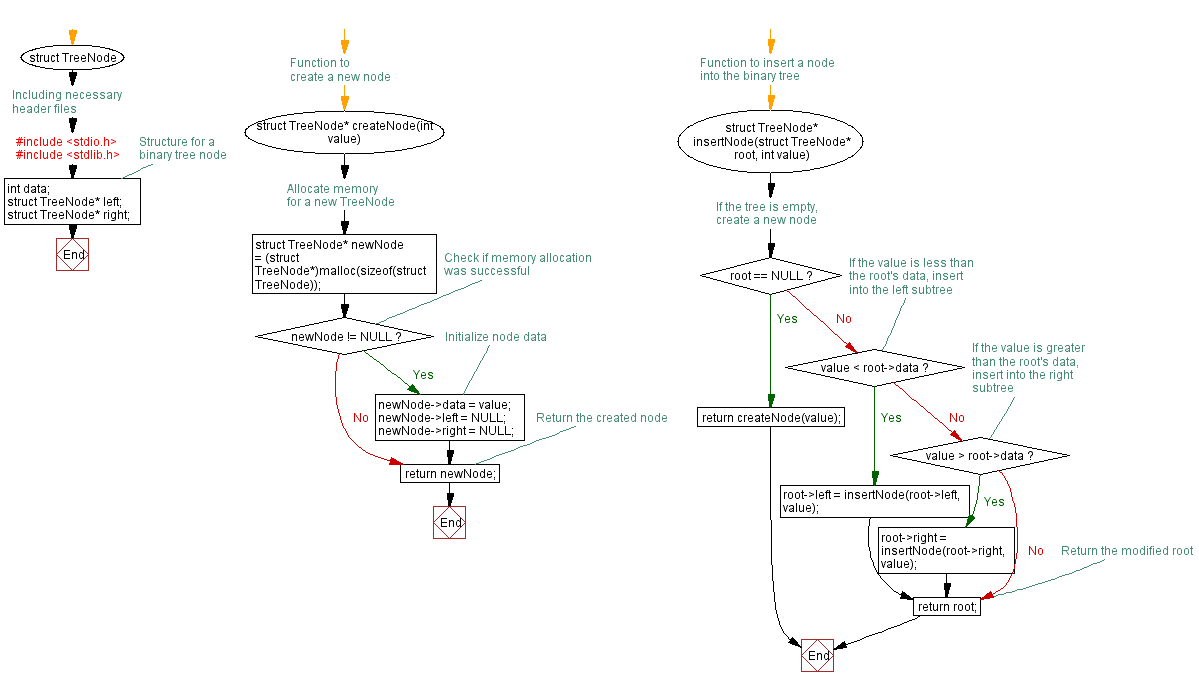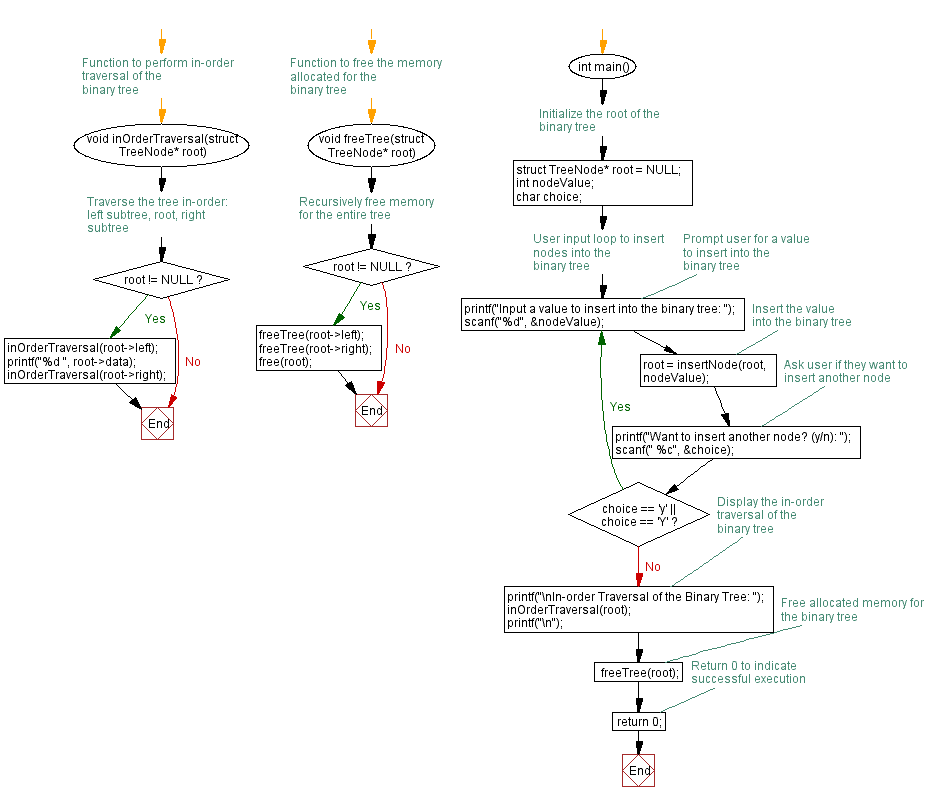C Program: Binary Tree creation with user input
1. Binary Tree Construction Variants
Write a C program that creates a binary tree. Allow users to input nodes and build a binary tree structure.
Sample Solution:
C Code:
// Including necessary header files
#include <stdio.h>
#include <stdlib.h>
// Structure for a binary tree node
struct TreeNode {
int data;
struct TreeNode* left;
struct TreeNode* right;
};
// Function to create a new node
struct TreeNode* createNode(int value) {
// Allocate memory for a new TreeNode
struct TreeNode* newNode = (struct TreeNode*)malloc(sizeof(struct TreeNode));
// Check if memory allocation was successful
if (newNode != NULL) {
// Initialize node data
newNode->data = value;
newNode->left = NULL;
newNode->right = NULL;
}
// Return the created node
return newNode;
}
// Function to insert a node into the binary tree
struct TreeNode* insertNode(struct TreeNode* root, int value) {
// If the tree is empty, create a new node
if (root == NULL) {
return createNode(value);
}
// If the value is less than the root's data, insert into the left subtree
if (value < root->data) {
root->left = insertNode(root->left, value);
}
// If the value is greater than the root's data, insert into the right subtree
else if (value > root->data) {
root->right = insertNode(root->right, value);
}
// Return the modified root
return root;
}
// Function to perform in-order traversal of the binary tree
void inOrderTraversal(struct TreeNode* root) {
// Traverse the tree in-order: left subtree, root, right subtree
if (root != NULL) {
inOrderTraversal(root->left);
printf("%d ", root->data);
inOrderTraversal(root->right);
}
}
// Function to free the memory allocated for the binary tree
void freeTree(struct TreeNode* root) {
// Recursively free memory for the entire tree
if (root != NULL) {
freeTree(root->left);
freeTree(root->right);
free(root);
}
}
int main() {
// Initialize the root of the binary tree
struct TreeNode* root = NULL;
int nodeValue;
char choice;
// User input loop to insert nodes into the binary tree
do {
// Prompt user for a value to insert into the binary tree
printf("Input a value to insert into the binary tree: ");
scanf("%d", &nodeValue);
// Insert the value into the binary tree
root = insertNode(root, nodeValue);
// Ask user if they want to insert another node
printf("Want to insert another node? (y/n): ");
scanf(" %c", &choice);
} while (choice == 'y' || choice == 'Y');
// Display the in-order traversal of the binary tree
printf("\nIn-order Traversal of the Binary Tree: ");
inOrderTraversal(root);
printf("\n");
// Free allocated memory for the binary tree
freeTree(root);
// Return 0 to indicate successful execution
return 0;
}
Output:
Input a value to insert into the binary tree: 50 Want to insert another node? (y/n): y Input a value to insert into the binary tree: 18 Want to insert another node? (y/n): y Input a value to insert into the binary tree: 73 Want to insert another node? (y/n): y Input a value to insert into the binary tree: 12 Want to insert another node? (y/n): y Input a value to insert into the binary tree: 9 Want to insert another node? (y/n): n In-order Traversal of the Binary Tree: 9 12 18 50 73.
Explanation:
In the exercise above,
- Structures:
- The program defines a structure "TreeNode" representing a node in the binary tree, containing data, left, and right pointers.
- Functions:
- createNode(): Allocates memory for a new node and initializes its data.
- insertNode(): Inserts a node into the binary tree based on the value, recursively.
- inOrderTraversal(): Performs in-order traversal (left subtree, root, right subtree) and prints the data.
- freeTree(): Frees the memory allocated for the binary tree.
- Main Function:
- Initializes the root of the binary tree.
- Asks users to input values for nodes in a loop and inserts them into the binary tree.
- Displays the in-order traversal of the binary tree.
- Frees the allocated memory.
- User Interaction:
- Users input values to create nodes in the binary tree.
- Users decide whether to insert another node (y/n).
- Memory Management:
- Memory is dynamically allocated for each node and freed at the end to prevent memory leaks.
- Execution:
- The program performs the specified operations and displays the in-order traversal of the created binary tree.
Flowchart:


For more Practice: Solve these Related Problems:
- Write a C program to create a binary tree by inserting nodes in level order and display the tree in a structured hierarchy.
- Write a C program to construct a binary tree from given pre-order and in-order traversal arrays.
- Write a C program to build a binary tree that accepts duplicate values and organizes them by inserting duplicates as right children.
- Write a C program to interactively construct a binary tree by letting the user specify parent-child relationships at runtime.
Go to:
PREV : C Program: Tree Structure Home.
NEXT : In-Order Traversal Variants.
C Programming Code Editor:
What is the difficulty level of this exercise?
Test your Programming skills with w3resource's quiz.
